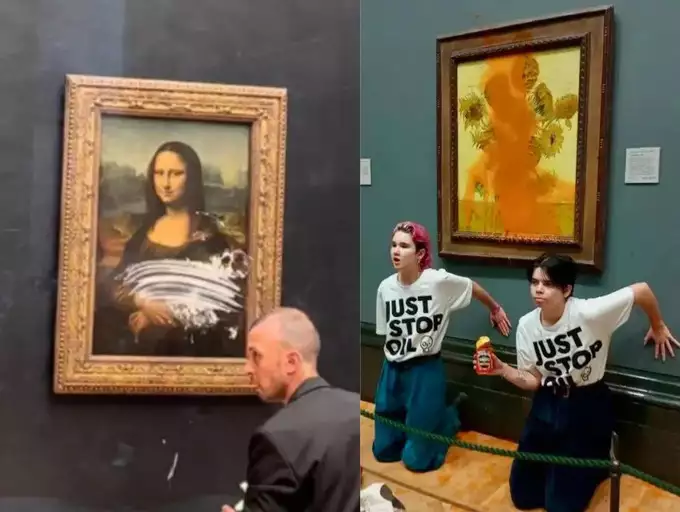
Every once in a while, we (and the whole art world) get the scare of our lives. Scary headlines rise recalling how historic paintings such as Da Vinci’s Mona Lisa, Van Gogh’s sunflowers as well as iconic landmarks such as the StoneHenge have all been defaced. The culprit almost always is a new form of protest: defacing art. But, why do people even do this? And what’s the climate movement got to do with it?
“There’s no thing such as bad publicity”
To explain this form of protest, let’s think of a simple scenario. Imagine every day of the week, some bully in the school takes your tuck shop money. You would (understandably) be upset and would want to bring this to someone’s attention. You can begin telling people about this in the playground but most likely, they won’t listen and will just walk by. So, a more effective form of activism – or raising awareness for your cause- would be spray painting the playground with a massive shape or icon or playing extremely loud music to garner attention. It may be very disruptive, and make everyone hate you, but a massive burst of colour plastered on the playground and booming rock music would definitely get some attention and perhaps get your voice heard. Let’s apply this to this situation: climate activism is a crucial topic but is definitely overseen. The activists who do these insane things, even called ‘criminally idiotic’ by a judge, do this to cause a scandal. Don’t forget, negative attention is attention after all.
“Why even do this?”
This form of activism falls under the terror management theory. This theory suggests that we hold such things (such as the Mona Lisa, StoneHenge etc.) as staple cultural things. When we see works of art that have been protected and preserved for decades become destroyed, we feel scared and insecure.
the Mona Lisa, StoneHenge etc.) as staple cultural things. When we see works of art that have been protected and preserved for decades become destroyed, we feel scared and insecure.
They damage our confidence in preservation and permanence. Environmental activists target art and natural landscapes because of their belief that we prioritise artistic landscapes over nature itself; if we feel so offended by a soup of beans thrown at Van Gogh’s sunflowers, why not at actual plants and flowers being destroyed? Here’s another explanation by an actual environmentalist on this topic:
“The function of art is for people to be able to understand the world that they live in and reflect on the human condition, but big art isn’t fulfilling that function. That’s the reason for us to be in museums: to tell people that we are in the middle of an emergency, and it is the time now for you to face that emergency.”
When you hear about these actions you may wince or shake your head but statistics prove that they don’t really harm campaigns. Although, focus is often shifted on the actions rather than on the protesters actual motives, as seen on newspaper articles that express dismay at the act of throwing soup on Van Gogh’s work but never mention why it was done (to protest the UK supporting new gas and oil fields being built by the way!).
“Earthly Scandals”
It was as recent as the 2nd of June 2024 that yet another painting was defaced. Although the works of art never get significantly damaged (as they are almost always underneath glass), scandal does erupt. Personally, I think that the environment is being harmed significantly and people are definitely sleeping on that. However, is it right to ‘ruin’ works of art, and cause a scare as well as public outcry to bring that to people’s attention? That’s for you to decide.

